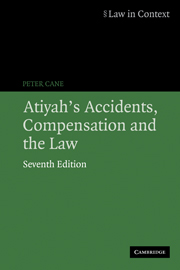Book contents
Summary
The seven years since I wrote the preface to the sixth edition have been ones of rapid and momentous change in the tort system, affecting most particularly the financing and settlement of personal injury claims. Some of these changes were foreshadowed in the previous edition; but it was hard to predict the precise contours of the revolution that was about to be triggered by the abolition of legal aid for most personal injury claims and the consequent growth of the claims management industry. Phrases such as ‘ compensation culture’, ‘ blame culture’ and ‘ insurance crisis’ have become part of the common currency of public debate and political rhetoric in Britain. At the same time, social security provision for the disabled and compensation for victims of crime have continued to engage the concern and attention of the government and the public, both being under review as I write. Nor is it only in Britain that personal injury compensation looms large in legal and political debate. In the USA, for instance, asbestos and medical malpractice litigation are matters of intractable and acrimonious disagreement. In Australia, as a result of turmoil in the liability insurance industry, ‘ tort reform’ became, for several months in 2002, the hottest issue in domestic politics, leading to the appointment of a committee to review personal injury law and, in its wake, major legislation in all jurisdictions. Despite widespread dissatisfaction with the tort system, the past decade has (ironically, perhaps) seen its further entrenchment in the political economy of personal injury compensation.
- Type
- Chapter
- Information
- Atiyah's Accidents, Compensation and the Law , pp. xiv - xviPublisher: Cambridge University PressPrint publication year: 2006

